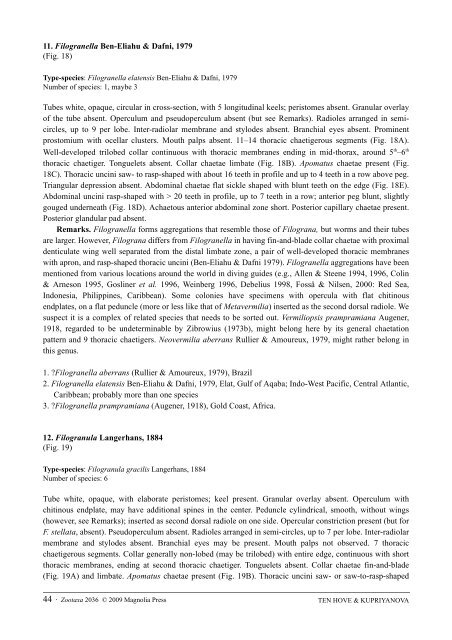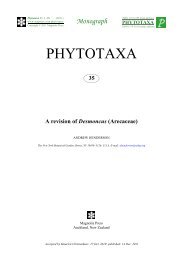Zootaxa, Taxonomy of Serpulidae (Annelida ... - Magnolia Press
Zootaxa, Taxonomy of Serpulidae (Annelida ... - Magnolia Press
Zootaxa, Taxonomy of Serpulidae (Annelida ... - Magnolia Press
You also want an ePaper? Increase the reach of your titles
YUMPU automatically turns print PDFs into web optimized ePapers that Google loves.
11. Filogranella Ben-Eliahu & Dafni, 1979<br />
(Fig. 18)<br />
Type-species: Filogranella elatensis Ben-Eliahu & Dafni, 1979<br />
Number <strong>of</strong> species: 1, maybe 3<br />
Tubes white, opaque, circular in cross-section, with 5 longitudinal keels; peristomes absent. Granular overlay<br />
<strong>of</strong> the tube absent. Operculum and pseudoperculum absent (but see Remarks). Radioles arranged in semicircles,<br />
up to 9 per lobe. Inter-radiolar membrane and stylodes absent. Branchial eyes absent. Prominent<br />
prostomium with ocellar clusters. Mouth palps absent. 11–14 thoracic chaetigerous segments (Fig. 18A).<br />
Well-developed trilobed collar continuous with thoracic membranes ending in mid-thorax, around 5 th –6 th<br />
thoracic chaetiger. Tonguelets absent. Collar chaetae limbate (Fig. 18B). Apomatus chaetae present (Fig.<br />
18C). Thoracic uncini saw- to rasp-shaped with about 16 teeth in pr<strong>of</strong>ile and up to 4 teeth in a row above peg.<br />
Triangular depression absent. Abdominal chaetae flat sickle shaped with blunt teeth on the edge (Fig. 18E).<br />
Abdominal uncini rasp-shaped with > 20 teeth in pr<strong>of</strong>ile, up to 7 teeth in a row; anterior peg blunt, slightly<br />
gouged underneath (Fig. 18D). Achaetous anterior abdominal zone short. Posterior capillary chaetae present.<br />
Posterior glandular pad absent.<br />
Remarks. Filogranella forms aggregations that resemble those <strong>of</strong> Filograna, but worms and their tubes<br />
are larger. However, Filograna differs from Filogranella in having fin-and-blade collar chaetae with proximal<br />
denticulate wing well separated from the distal limbate zone, a pair <strong>of</strong> well-developed thoracic membranes<br />
with apron, and rasp-shaped thoracic uncini (Ben-Eliahu & Dafni 1979). Filogranella aggregations have been<br />
mentioned from various locations around the world in diving guides (e.g., Allen & Steene 1994, 1996, Colin<br />
& Arneson 1995, Gosliner et al. 1996, Weinberg 1996, Debelius 1998, Fosså & Nilsen, 2000: Red Sea,<br />
Indonesia, Philippines, Caribbean). Some colonies have specimens with opercula with flat chitinous<br />
endplates, on a flat peduncle (more or less like that <strong>of</strong> Metavermilia) inserted as the second dorsal radiole. We<br />
suspect it is a complex <strong>of</strong> related species that needs to be sorted out. Vermiliopsis prampramiana Augener,<br />
1918, regarded to be undeterminable by Zibrowius (1973b), might belong here by its general chaetation<br />
pattern and 9 thoracic chaetigers. Neovermilia aberrans Rullier & Amoureux, 1979, might rather belong in<br />
this genus.<br />
1. ?Filogranella aberrans (Rullier & Amoureux, 1979), Brazil<br />
2. Filogranella elatensis Ben-Eliahu & Dafni, 1979, Elat, Gulf <strong>of</strong> Aqaba; Indo-West Pacific, Central Atlantic,<br />
Caribbean; probably more than one species<br />
3. ?Filogranella prampramiana (Augener, 1918), Gold Coast, Africa.<br />
12. Filogranula Langerhans, 1884<br />
(Fig. 19)<br />
Type-species: Filogranula gracilis Langerhans, 1884<br />
Number <strong>of</strong> species: 6<br />
Tube white, opaque, with elaborate peristomes; keel present. Granular overlay absent. Operculum with<br />
chitinous endplate, may have additional spines in the center. Peduncle cylindrical, smooth, without wings<br />
(however, see Remarks); inserted as second dorsal radiole on one side. Opercular constriction present (but for<br />
F. stellata, absent). Pseudoperculum absent. Radioles arranged in semi-circles, up to 7 per lobe. Inter-radiolar<br />
membrane and stylodes absent. Branchial eyes may be present. Mouth palps not observed. 7 thoracic<br />
chaetigerous segments. Collar generally non-lobed (may be trilobed) with entire edge, continuous with short<br />
thoracic membranes, ending at second thoracic chaetiger. Tonguelets absent. Collar chaetae fin-and-blade<br />
(Fig. 19A) and limbate. Apomatus chaetae present (Fig. 19B). Thoracic uncini saw- or saw-to-rasp-shaped<br />
44 · <strong>Zootaxa</strong> 2036 © 2009 <strong>Magnolia</strong> <strong>Press</strong><br />
TEN HOVE & KUPRIYANOVA
















